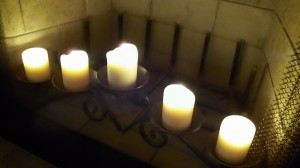
Want to save electricity? Light candles and forget about changing the time twice a year.
Daylight saving time is here. If we could keep it, I would quit my complaining about it. I’m not against gaining an hour of daylight at the end of the day. What I’m against is the time change twice a year.
Judging from the online chatter, lots of you resent the change as well. And we have science on our side. The Houston Chronicle, in its blog, quoted a biologist to the effect that the abrupt time switch messes with people’s circadian rhythms. As a result, accidents increase right after the switch from standard to daylight time in March and vice versa in the fall. Medical problems such as heart attacks also rise. And all for what?
Daylight time is supposed to save electricity. But lighting now accounts for only a small part of electric demand, and anyway, people live and work in buildings where the lights are on regardless of how dark or light it is outside. So there is no “saving” in daylight saving time.
If you have a day job, though, the extra hour of light in the evening is nice. It allows you to do more things outdoors longer, such as walking, running, working in the yard or even biking. If Congress wanted to do something for Americans’ health, it would make daylight saving time permanent. And if that’s a problem on winter mornings when kids have to wait for the bus in the dark, let schools start an hour later. That would be much simpler and safer than making the whole country risk more accidents and more illness twice a year. (hh)


Time switch may make you sick
Want to save electricity? Light candles and forget about changing the time twice a year.
Daylight saving time is here. If we could keep it, I would quit my complaining about it. I’m not against gaining an hour of daylight at the end of the day. What I’m against is the time change twice a year.
Judging from the online chatter, lots of you resent the change as well. And we have science on our side. The Houston Chronicle, in its blog, quoted a biologist to the effect that the abrupt time switch messes with people’s circadian rhythms. As a result, accidents increase right after the switch from standard to daylight time in March and vice versa in the fall. Medical problems such as heart attacks also rise. And all for what?
Daylight time is supposed to save electricity. But lighting now accounts for only a small part of electric demand, and anyway, people live and work in buildings where the lights are on regardless of how dark or light it is outside. So there is no “saving” in daylight saving time.
If you have a day job, though, the extra hour of light in the evening is nice. It allows you to do more things outdoors longer, such as walking, running, working in the yard or even biking. If Congress wanted to do something for Americans’ health, it would make daylight saving time permanent. And if that’s a problem on winter mornings when kids have to wait for the bus in the dark, let schools start an hour later. That would be much simpler and safer than making the whole country risk more accidents and more illness twice a year. (hh)
Tags: Daylight saving time